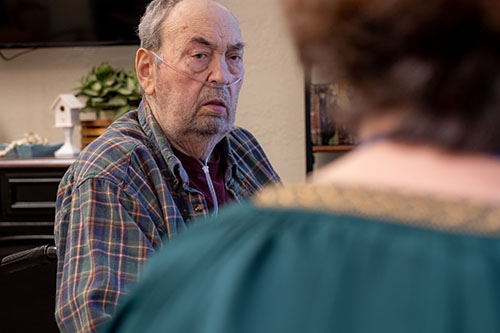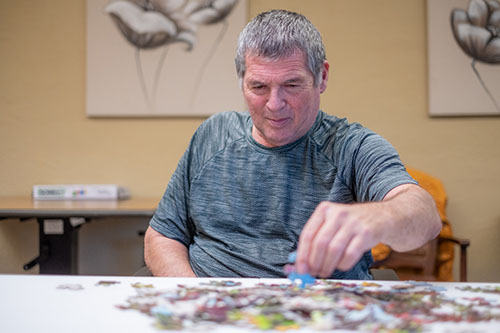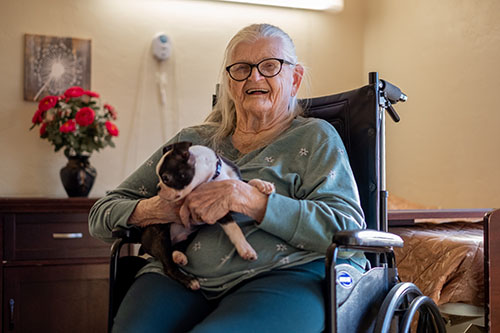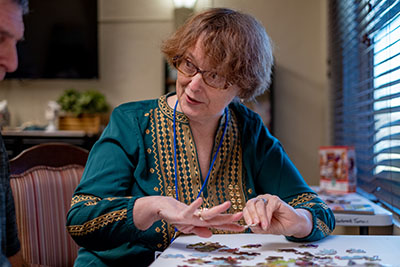
On Dec. 23, Ki Soon Hyun, an 83-year-old woman with memory issues, moved into the Mt. Hood Senior Living facility.
Two days later on Christmas Day, she was found dead in a nearby wooded area after wandering out of the facility and spending the night alone in freezing temperatures.
The tragedy spurred numerous questions about how an elderly woman could walk out of a state-regulated care facility with no one noticing.
A subsequent investigation by the Oregon Long-Term Care Ombudsman program found the Mt. Hood Senior Living facility failed in multiple ways to protect Ki Soon Hyun. The findings showed the facility failed to lock and secure doors, to properly train staff and to properly staff the facility to care for its residents.
Those failures, and ongoing safety concerns, led the Oregon Department of Human Services to close down the facility in January.
The mission of the Long-Term Care Ombudsman, a federally-mandated program, is to protect individual rights, promote independence, and ensure quality of life for Oregonians living in long-term care and residential facilities and for Oregonians with decisional limitations.

According to the program’s website, certified ombudsman volunteers are independent citizen advocates who listen to and address the concerns of residents living in long-term care facilities.
They investigate concerns, work with those involved to resolve problems, and help to ensure resident rights and dignity. Matters can range from the food service to issues with daily care.
One of the key ways to accomplish its mission is to recruit and train volunteers to make regular visits to state-regulated care facilities to make sure the residents are treated well and the facilities follow state laws as well as their own rules and policies.
Valerie Conner of Pendleton is a volunteer recruiter for Umatilla County with the Long-Term Care Ombudsman program. She said the presence of a volunteer ombudsman results in better care for the residents.
“An ombudsman causes an improvement in care, simply by showing up,” Conner said. “Something happens when someone is watching out, chatting with the residents, following up on concerns or complaints, participating in resident council meetings or activities. Everyone ups their game.”
Conner said caregivers and facility staff know what their duties and responsibilities are, but still benefit when an ombudsman makes regular visits.
“When there is a witness, they shine,” she said. “When they don’t know when the ombudsman might happen by, they shine more often and the residents notice.”
The problem, said Conner, is there simply are not enough volunteers to check up on the state’s hundreds and hundreds of care facilities.

She estimated there are only eight ombudsman for the 67 facilities in District 9, which encompasses Umatilla, Morrow, Baker, Wallowa, Union, Gilliam, Sherman, Wheeler, Grant, Harny and Malheur counties.
Fred Steele, agency director for the ombudsman program, said it’s actually less than that.
“Maybe five or six,” he said. “Our numbers are significantly down statewide and definitely in eastern Oregon.”
The 67 facilities in District 9 include nursing homes, memory care facilities, adult foster home, assist living facilities and residencies for the developmentally disabled.
To give an idea of the need for more than just the current five or six volunteers in District 9, Conner said each facility should ideally have one or two volunteers checking in periodically.
Conner said the most important role of the volunteer ombudsman is to handle the concerns of the residents. The program has a reporting system for complaints and a booklet that helps determine when a concern rises to an official complaint. It takes some detective work to get to the bottom of some concerns, Conner said.
“If you are a detective or mystery fan, this will be your most favorite part of this task – figuring out who to ask and how to ask the questions to get the whole story and to determine where it needs to go next.”
When an issue does rise to the level of an official complaint, the volunteer collects the information and passes it on to a district deputy. Kat Thomas is the deputy for District 9. She then will work with the appropriate state agency assigned to investigate the case.
“People are stressing so much longer” if an agency has to get involved, Conner said.
Some issues involving residents require a little problem solving. When she was volunteering at a facility in Washington County, a resident complained about another resident’s smoking habits. Conner spent some time talking to people and asking questions.
In that particular case, the smoker was suffering from PTSD and simply had to chain smoke throughout the day. During business hours, when the facility was fully staffed, the resident would be walked outside to smoke, but in the evenings with less staff, the resident stayed inside to smoke. His neighbor had asthma and could not breathe clearly nor sleep well.
The smoking resident was due to be transferred, but not for several weeks. In the meantime, Conner found a solution by moving the asthmatic resident into an empty apartment until the smoker was transferred out.
“It takes some brainstorming to make sure the comfort of one resident does not infringe on the comfort of another resident,” she said.
Other concerns may involve a lack of socialization.

“It might be a case of an elderly resident losing track of her church friends,” Conner said. “In that situation, you get in touch with the church and arrange for visits to the resident.
“You ask a bazillion questions and hopefully, the answer comes eventually,” Conner said. “Then you get to close the case and say, ‘Next.’ ”
Just as there is a shortage of volunteer ombudsman, there is also a shortage of qualified staff working at care facilities.
“Too many are understaffed,” Steele said. That is due to a couple of factors, he said. “I would contend it’s because of business decisions.” In other words, it’s cheaper to hire fewer staff. Nursing homes have state-mandated staffing requirements, but they are rarely enforced. Steele said the Oregon Department of Human Services, which oversees nursing homes, has “not embraced” enforcing staffing requirements. A letter to a nursing home indicating it is out of compliance is often the full extent of DHS’ involvement, Steele said.
The staffing of long-term care facilities in general took a hit during the pandemic, Steele said.
“COVID really decimated the human service ranks in long-term care facilities,” he said. “A large number of them left the industry entirely.”
Conner painted a common scenario in care facilities when staffing is an issue.
“What happens on evening or night shift when some workers are no-show?” she asked. “In this scenario, there are two certified nursing assistants (CNAs) and one medication aid for 40 residents. Over half of the residents will need assistance getting ready for bed. During the night at least five will need assistance to the toilet. How long does it take to get someone ready for bed? Can a CNA assist several residents at a time, popping in and out of resident apartments? How long can a CNA leave someone on the toilet before dignity is compromised?”
With insufficient staffing, the role of the volunteer ombudsman becomes even more important.
The ombudsman works directly with the facility managers and staff to make sure the residents’ rights are respected and treated with dignity. Conner said the intent of the volunteer is not to get into an adversarial relationship with a facility’s staff, but to form a partnership to provide the best care for the residents.
“We help caregivers do their best,” Conner said. “For me, dignity is foremost in what I hope to see in a long-term care home. For staff, the facility is where they go for work before returning home at the end of the day. The residents, however, live there full-time.”
Conner said that fact can sometimes be forgotten by staff, so she has facilitated “niceness lessons” for all staff to remind them of two things – first, their job is to serve the residents, and two, the facility is the residents’ home.
Conner said that without a volunteer ombudsman, many residents would keep their concerns to themselves out of fear of retaliation.
“They fear they will be kicked out, which they can’t be,” Conner siad. “But they can be shunned or treated rudely. And that’s not right.”
In those cases, an ombudsman must serve as the voice of the resident and ask “really pointed questions to staff to get to the bottom of an issue.”

The ombudsman volunteer serves as a trusted friend of the residents. But that trust has to be earned. And earning that trust often requires simply showing up and visiting with them. Conner said when she visits a facility for the first time, she immediately seeks out the “quiet” residents. Loneliness and isolation is not uncommon in care facilities, she said.
“When I visit a new facility, I ask to see the resident who keeps to themselves and isolates,” Conner said. “Then I work with them to get them involved in activities. Isolation is not good for anyone.”
Conner said no experience is necessary to become a volunteer with the ombudsman program. Those signing up to volunteer receive comprehensive training in the rules and policies for care facilities from the Office of the Long Term Care Ombudsman. The training takes place online.
Conner said once the training is complete, volunteers are assigned to a facility, usually near their home. Volunteers are reimbursed for their mileage.
The role of the ombudesman volunteer is a rewarding one, said both Conner and Steele.
“It’s being an advocate for fellow community members living in care facilities that need support,” said Steele.
“We lift up the workers and support the residents,” Conner said. “What better task?”
For more information on the program and how to volunteer, visit on the Oregon Long-Term Care Ombudsman website.










